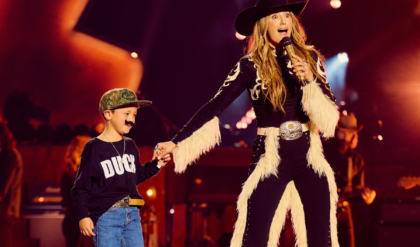As the nation gears up for the 4th of July celebrations, country music superstar Blake Shelton has dropped a bombshell that’s igniting conversations far beyond the airwaves. On Friday, June 27, 2025—just a week before Independence Day—Shelton released the music video for his hit single “Stay Country Or Die Tryin’,” a track from his latest album For Recreational Use Only. The video, a patriotic ode to seven generations of a family’s rural legacy, has captivated fans with its sweeping narrative. But its use of artificial intelligence to craft the visuals has sparked a mix of awe and unease, particularly with unsettling moments like distorted faces in a wedding scene, leaving viewers questioning the boundaries of technology in art.
The timing of the release couldn’t be more fitting. With the 4th of July looming, Shelton’s video taps into a surge of national pride, aligning perfectly with the holiday’s themes of freedom and heritage. “Stay Country Or Die Tryin’,” written by Drew Parker, Graham Barham, Sam Ellis, and Beau Bailey, is a gritty anthem celebrating rural resilience, faith, and family—echoes of Shelton’s earlier hits like “Ol’ Red” and “God’s Country.” The song, which Shelton has called a return to his roots, debuted on country radio charts in April and has climbed into the top 40, buoyed by its high-energy live performances, including a standout set at CMA Fest 2025. The music video, premiered via CMT and showcased on the Times Square Paramount Billboard, amplifies this message with a story spanning seven generations, depicted through the life of a single farmhouse.
Directed by Shelton’s longtime collaborators Adam Rothlein and Jennifer Ansell of Tiny Terror Productions, the video employs cutting-edge AI technology to weave its tale. It begins with a black-and-white scene of a young couple planting a tree in the 19th century, the farmhouse rising behind them. As the narrative progresses, the footage transitions to color, showing the family through wars, harvests, and celebrations—births, weddings, and quiet deaths—all centered around that same tree growing to maturity. The AI effects create a seamless flow of time, with generations aging and the home evolving, a visual metaphor for enduring values. Shelton himself has praised the approach, noting in a statement, “It’s a way to tell a story that feels alive, like it’s been passed down through my own family.”
Yet, the video’s reliance on AI hasn’t gone unnoticed—or unchallenged. While the technology delivers a polished, cinematic quality, it also introduces jarring imperfections. The most talked-about flaw occurs during a wedding scene, where the guests’ faces appear distorted—eyes misaligned, mouths stretched unnaturally, and features blurred as if melting into the background. Another moment, a family reunion, shows children with elongated limbs and uncanny smiles, adding an eerie undertone to the otherwise wholesome narrative. Fans on social media have dubbed these glitches “AI ghosts,” with some comparing them to early video game graphics or haunted portraits. “It’s like the family’s being watched by creepy AI clones,” one X user posted, sparking a wave of memes featuring distorted faces overlaid with patriotic filters.
The use of AI in music videos isn’t new—artists like The Weeknd and Billie Eilish have experimented with it—but Shelton’s approach stands out for its ambition and its flaws. Industry insiders suggest the distortions stem from the AI’s struggle to render complex human expressions and group dynamics, a limitation when training data prioritizes individual portraits over crowded scenes. Tiny Terror Productions has remained tight-lipped, but a source close to the project told Billboard that the team embraced the imperfections as “a raw, human touch in a digital world.” Shelton, in a recent interview with Country Weekly, defended the choice: “It’s not perfect, but it’s real. Those glitches show the effort to capture something bigger than just pretty pictures.”
Reaction to the video has been a rollercoaster. Fans of Shelton’s traditional country roots have hailed it as a bold evolution, with comments like “Blake’s keeping country alive with this tech!” flooding his Instagram. The patriotic theme, underscored by American flags waving over the farmhouse and lyrics about “red, white, and blue,” resonates strongly ahead of the 4th of July, with streams of the song jumping 80% on Spotify since the video’s release. However, critics and purists argue it dilutes the authenticity Shelton champions. “AI can’t feel the dirt under your boots,” one fan wrote on X, echoing a sentiment from traditionalists who’ve long debated the genre’s direction—debates Shelton himself stirred years ago with comments about “grandpa’s music.”
The distorted faces have fueled a broader conversation about AI in entertainment. Some see it as a creative frontier, allowing artists to craft narratives impossible with live footage—seven generations in one video would require decades or costly CGI. Others worry it risks replacing human effort, with one Rolling Stone reviewer noting, “The glitches remind us AI isn’t ready to fully replace the soul of country storytelling.” Social media polls reflect the divide: a survey on X showed 55% of respondents loved the innovation, while 45% found the distortions distracting, with many suggesting a hybrid approach blending AI and real actors.
Shelton’s team has leaned into the buzz. The video’s premiere on the Times Square billboard drew crowds, and a behind-the-scenes clip released Monday, June 30, 2025, at 11:33 AM +07, shows Shelton laughing with the directors as they tweak AI settings. “We wanted to push the envelope,” he said in the clip. “If a face looks a little weird, it’s part of the journey.” Fans have responded with enthusiasm, with one posting, “Those distorted wedding guests are my new favorite part—so quirky!” The video’s YouTube views hit 2 million within 48 hours, a testament to its viral appeal despite the imperfections.
Culturally, the release taps into the 4th of July spirit. The video’s narrative—family resilience across generations—mirrors the holiday’s themes of endurance and unity. Scenes of children playing under the tree, veterans saluting the flag, and a grandmother teaching a quilt pattern evoke a nostalgic patriotism that resonates with Shelton’s fanbase. The AI-enhanced transitions, even with their flaws, add a futuristic twist, blending old and new in a way that feels uniquely American. “It’s like a time capsule with a glitch,” a fan commented on Instagram, capturing the video’s dual nature.
The distortion controversy has also sparked technical discussions. Experts suggest the AI, likely trained on vast datasets of rural imagery, struggled with the wedding scene’s crowded composition, leading to facial anomalies. A tech analyst on X noted, “AI excels at landscapes but falters with human crowds—Shelton’s team might need more data refinement.” Tiny Terror Productions could address this in future edits, but for now, the glitches are part of the video’s identity, prompting debates about whether to fix them or embrace the imperfection.
Shelton’s career trajectory adds context to the bold move. After leaving Warner Music Nashville in 2024 for BBR Music Group, his album For Recreational Use Only marked a return to his Oklahoma roots, with “Stay Country Or Die Tryin’” as a defiant anthem. The AI video aligns with his recent push to innovate, following the success of “Texas,” which topped charts in 2024. Yet, it risks alienating purists who prefer the organic feel of his early work like “Ol’ Red.” “He’s walking a tightrope,” a music critic told CMT, “balancing tradition with tech.”
As the 4th of July approaches, the video’s reception will likely shape Shelton’s summer tour. Fans attending his upcoming shows, starting July 6 in Oklahoma, may expect live renditions with AI visuals, though some have suggested petitions for a re-edit. For now, the distorted faces—those eerie wedding guests—have become a talking point, a quirky footnote in a patriotic tale. At 11:33 AM +07 on June 30, 2025, the story continues to unfold, with Shelton’s gamble on AI proving that even imperfections can strike a chord in the heart of country music.





